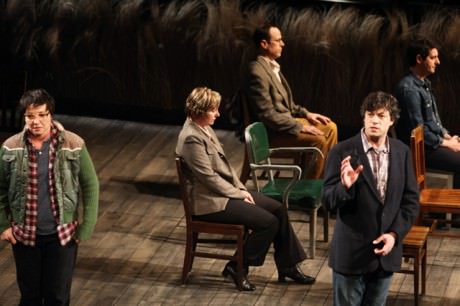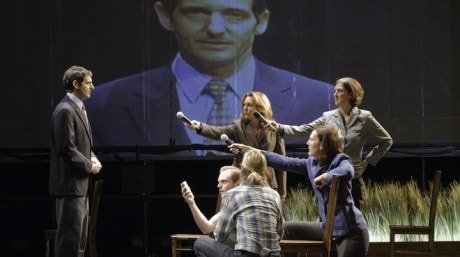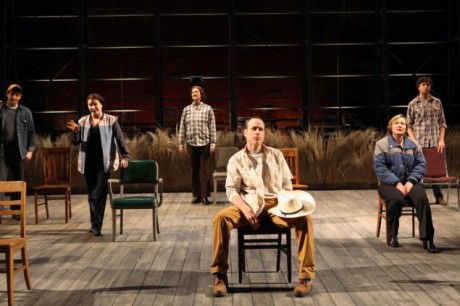Let’s get this out of the way: I cried. A lot. And I wasn’t the only one.
The crying started before a single word of The Laramie Project Cycle was even spoken. At Saturday’s pre-show Artist Talk, a young man from Ohio – about the same age that Matthew Shepard would have been had he not been brutally murdered – confessed that he wouldn’t be alive if it weren’t for The Laramie Project and the work done by the Matthew Shepard Foundation. Matthew’s mother, Judy Shepard, and Moisés Kaufman, Tectonic Theater Project‘s Artistic Director, openly wept.

It’s not the first time they’ve heard a story like this.
When the ten members of Tectonic descended on Laramie in 1998 to chronicle the aftermath of Matthew Shepard’s murder, tape recorders in hand, they had little idea of the impact their work would have. Fifteen years later, The Laramie Project is one of America’s most frequently produced plays; there have been almost 900 productions of Laramie in the last five years alone. When The Laramie Project: Ten Years Later premiered in 2009, it was produced simultaneously on 150 stages, including productions in Europe and Australia. The Laramie Project Cycle, currently in production at Brooklyn Academy of Music (BAM), is a landmark revival. The production marks the NYC premiere of The Laramie Project: Ten Years Later, and the first time that Tectonic has produced full stagings of the two plays together in repertory.
Along with co-directors Moisés Kaufman and Leigh Fondakowski, six more of the original company members (Stephen Belber, Amanda Gronich, Mercedes Herrero, Andy Paris, Barbara Pitts, and Greg Pierotti) have returned for the production, and you can tell that Tectonic has been actively living with the play since its inception. The reactions and emotions are fresh and raw, and it’s easy for the audience to imagine the conversations happening for the first time on the stage in front of us. It speaks to the talent of the newer company members (Michael Winther and Libby King) that I was hard-pressed to differentiate them from the veterans. King is particularly effective portraying the younger members of the Laramie community. The cast of characters is largely likable, and it’s easy to see how the people of Laramie were seduced by the narrative that “things like this don’t happen here.” But it did happen, as one character points out, and watching the people of Laramie struggle with that fact is almost as heart-breaking as the murder itself.
Where the original Laramie is emotional, Ten Years Later is intellectual. Rather than a conversation about an event, Ten Years Later is a conversation about that conversation. The work deals with the ways that Wyoming and the town of Laramie have changed in the ten years since Matthew Shepard’s death, chronicling both attitude changes and legislative developments. If the audience applause that accompanies each victory is a little self-congratulatory, the failures are sobering. Many of the characters have latched on to the idea that Matthew’s death was a robbery gone bad, and their on-stage denial is a painful reminder that real people have made that choice as well.

Ten Years Later is best thought of as a long epilogue rather than a second play; without the emotional context of the original Laramie, it’s hard to see the work standing on its own as an independent production. Marathon weekend presentations may be hard on the theatre-goer, but the connections between the two works are easier to appreciate than even the showings on consecutive weekdays.
The two productions are not without their (admittedly minor) issues. The set, designed by Robert Brill is evocative of small-town America: prairie grass, simple wooden chairs and tables, and a large billboard-like structure. But while the set fits the tone of the production, many of the transformations of the stage feel unnecessary. Little is gained by turning the setting wholesale into the Fireside Lounge where Matthew met his murderers, and the prison guard pacing in the background doesn’t add anything to an interview with one of Matthew’s killers. The set of Ten Years Later also includes a number of additional chairs in the background to represent the growing conversation around the subject of hate crimes and tolerance, but the chairs are never used or directly relevant to the action. Both plays are at their best when they can focus directly on the people involved.
At the Artist Talk, Moisés Kaufman said, “I keep waiting for The Laramie Project to feel historical, and it doesn’t.” The real tragedy of Matthew Shepard’s death is that, despite our best intentions, it could happen again today – or tomorrow. The beauty of The Laramie Project Cycle, then, is that it continues to have a message worth hearing.

Running Time: The Laramie Project is two hours and 45 minutes, including two intermissions. The Laramie Project: Ten Years Later is one hour and 45 minutes, with one intermission.
The Laramie Project Cycle plays through February 24, 2013 at the Brooklyn Academy of Music – Harvey Theater – 651 Fulton St, in Brooklyn, NY. For tickets, call the box office at (718) 636-4100, or purchase them online.
LINK
Read the Program Notes.
https://youtu.be/mg971yBx1q4




